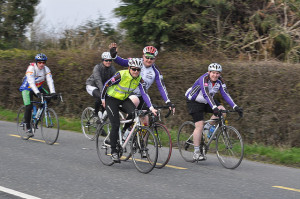Many of us have either heard from friends or experienced for ourselves the excitement of participating in cycling events for charity. “Pedaling for a purpose,” as blogger Paula Holmes-Eber calls it, brings a sense of camaraderie, friendship, accomplishment, and adventure from participating in organized group rides for causes. As an experienced cyclist who has traveled to dozens of countries raising thousands of dollars, Holmes-Eber breaks down cycling for charity into four different categories for those interested in cycling for a cause:
- Organized Charitable Rides
- Independent Charitable Rides
- Independent Ride for Existing Charity
- Completely Independent Charity Rides
Organized Charitable Rides
Organized rides are the easiest to participate in and the best for those who have never cycled for a cause before. These types of rides have been started and maintained by established, (mostly) nonprofit organizations. These rides have an advantage because the cause is already established and the race has already attracted significant public attention. Riders who raise funds for these types of rides usually have success because others are attracted to the credibility of the cause and the are familiar with the sponsors. There is not much to think about or plan or prepare, (other than training physically), for the event. The organizations that run these charity rides offer help and tips on how to raise money and oftentimes provide food and accommodations, requiring the cyclist to just show up and ride. These events can be highly- enjoyable and offer an opportunity for you to sign up with friends and family. If you are interested in cycling for a cause, start with these types of established rides.
CyclingUtah offers a calender every year with organized rides. Here are a few known charity races coming up this month and in August:
July 12 — Good News Jail and Prison Ministry Fundraiser Bicycle Ride
July 19 — Pedal-Away Parkinson’s
July 19 — The GLMR Century
August 15 & 16 — Bear Pa Challenge Charity Cycling Tour
August 16 — Utah Rides for Cancer
August 23 — Cache Valley Century Tour
While these are examples of charitable rides, Utah also offers dozens of organized races to join “just for fun” that are not necessarily for charitable causes.
Independent Charitable Rides
While organized charitable rides are probably the best way to begin for someone who has never cycled for a cause before, independent charitable rides offer you the opportunity to organize your own “for a cause” that is important to you. You can establish your own cause for cycling and hold your own ride. This will require significantly more time and money than participating in someone else’s ride. You will need to plan the route, the training, and the fundraising. When you want to ride independently, according to Holmes-Eber, you either should ride for “an established nonprofit or ride without working with a nonprofit.”
Steve Fabes offers tips on how to raise funds for charity rides and how to start your own rides on FreeWheelingFrance.com
Independent Ride for Existing Charity
This ride combines the first and second options, as long as the charity does not already have a cycling race that it sponsors. Using an existing charity makes things easier because you are working with an established team who is dedicated to the cause you want to cycle for. The charity may be able to help cover costs and help you fundraise for the ride. Many charities, however, are strict when working with others to form an independent ride because they are subject to certain legal liabilities and will also be worried about connecting reputation with yours.
Completely Independent Charity Ride
If there isn’t a charitable organization that represents your cause, you can still ride. Instead of raising money, you will be more focused on raising public awareness and getting your story out there. In today’s social media world, that should not be so hard to do. Riding independent means you may want to establish your own nonprofit organization, which is a major commitment. This independence allows you to say and do what you want, to set up your own cause and attract attention from others who might be interested as well. For more detailed information from Paula Holmes-Eber’s own experience, visit adventurecycling.org.
Photo courtesy of: Peter Mooney

